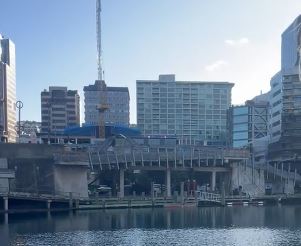In September 2024 I posted that the City to Sea Bridge in Wellington is my favourite bit of infrastructure, largely because it is so generously proportioned that it feels like a part of the city rather than a narrow footbridge.

This structure is now threatened with imminent demolition after it was found not to be up to earthquake code, the price of upgrade too great, and a judicial review to save it failed. This bridge, which connects the civic precinct in Wellington with the waterfront, bridging over the six-lane Jervois Quay, was only built in 1993, and was strengthened in 2011. But earthquake codes have become stricter following the Christchurch and Kaikoura earthquakes and it is no longer deemed economically viable to upgrade this bridge. Wellington City Council have voted to demolish it and replace it with a pedestrian crossing in the short term.
While an at-grade pedestrian crossing technically serves the same purpose as the City to Sea bridge for a much lower cost, in reality this assumption undervalues the structure. Pedestrians will have to wait and stop the traffic on Jervois Quay, instead of wandering across, (with views over the harbour) at their leisure, which is what they enjoy now. One of the joys of Wellington is its access to the waterfront, and a big part of that is this step-free prioritised causeway over the six lane arterial road severing city from sea.
Bridges reach the end of their life all the time. Typically, they are replaced like with like, or even upgraded, like the single lane Kopu Bridge near Thames, which was replaced with a dual lane bridge in 2011, or the Old Mangere Bridge in south Auckland, a walking and cycling bridge which was eventually replaced with another pedestrian bridge in 2022.
It’s easy to see how losing a bridge over water will sever communities. A vital lifeline is lost, and so usually there is a business case for replacing like with like. Roads also cause severance. A six lane highway in the centre of the capital city forms a very effective barrier to movement. Replacing the City to Sea Bridge with an at-grade pedestrian crossing would be like replacing the Old Mangere Bridge with a ferry. While technically it does the job, it no longer prioritises pedestrian connectivity.
The significantly cheaper option of a pedestrian crossing can get pedestrians across the road, even where this road carries 40,000 vehicles a day. But another pedestrian crossing is not really what is needed. Jervois Quay already has several signalised at-grade crossings. The point is not that a bridge can technically be replaced with a pedestrian crossing to get people across the road. The point is that a wide, causeway-like bridge offers other intangible benefits to Wellingtonians and visitors alike whose perception of a city by the sea will be eroded. I’d liken it to a wildlife corridor bridge, such as you see in North America or Sweden, to enable megafauna like moose to cross roads between habitats. It is in fact a human corridor bridge, enabling humans to cross between two areas of interest or destinations. However, capturing the equivalent monetary benefits of such pedestrian connections is challenging, which is why on paper a pedestrian crossing will do the job.
Unfortunately this wonderful feature of the city has suffered by association because once-vibrant Civic Square has been a construction site for many years while the Town Hall, City Library and other civic buildings are themselves earthquake strengthened, lessening footfall in the area. By the time those buildings come back online, the human corridor bridge from Civic Square to the waterfront will likely no longer be there. The council has said it will consider options to replace the bridge at a ‘later date’. Let’s hope that that consideration recognises the value of this human corridor bridge and replaces like with like.
Discover more from josephinedraper.com
Subscribe to get the latest posts sent to your email.
1 Comment
Kathy Clarke · 03/09/2025 at 00:51
This is an excellent article Josephine. It expertly sums up the function of the bridge. It is also an artistic feature of Wellington.
I too hope it is replaced like with like.